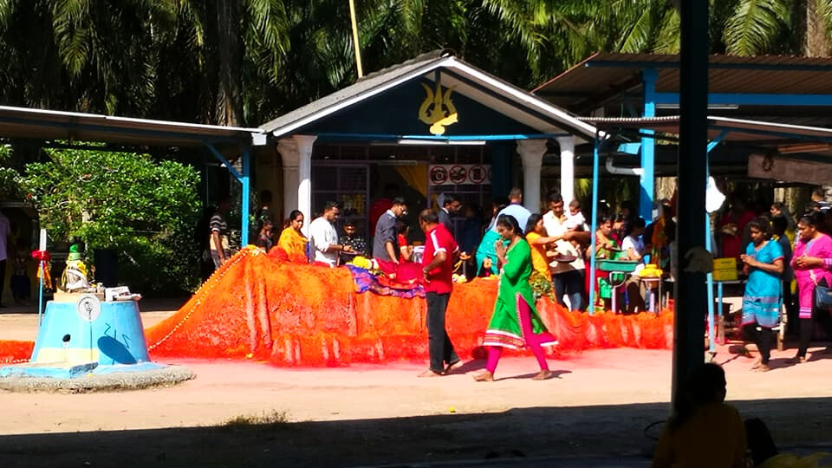Surrounded and tucked in the lush green stretches of Kuala Selangor’s plantations lies a temple unlike any other : Sri Anggala Parameswary Peachiamman Temple - Ladang Bukit Talang ( Riverside Estate), a sacred sanctuary standing strong for over 125 years. But beyond its age and beauty, lies a story built on faith and a strong bond between the goddess and her devotees.
The goddess here doesn’t sit on a high pedestal. Instead, she reclines close to the earth, eyes fixed on the sky above. Her divine posture is no coincidence. It’s believed she watches over the movements especially the ‘Navagrahas’ shielding her devotees from misfortunes and guiding them safely through life’s stormy paths. Those who step into this temple often speak of a strange calm, a spiritual armour that surrounds the shrine, making them feel protected, even healed.
The origins of this powerful temple trace back to a humble couple from the village of Maniyanoor in Tamil Nadu - Marimuthu Mudaliar and his devoted wife, Karuppayee. As part of the wave of Tamil immigrants seeking new beginnings in Malaya, they carried not just hope, but also their deep devotion to their family deity, Sri Anggala Parameswari. In their small hut within the plantations, worship continued quietly, yet fervently.
Then came a divine calling. The goddess appeared in a vision, urging them to establish a proper shrine at a spot she revealed. Sacred items brought from their ancestral village were buried according to ‘shakti’ rituals, and soon after, a mysterious mound, a ‘manputru’ - began forming on its own. With tears in her eyes and faith in her heart, Karuppayee moulded this mound into the likeness of Sri Pechaiamman, just like back home in Maniyanoor. And just like that, the spiritual heartbeat of this plantation community was born.

What followed was nothing short of miraculous. Women hoping for children were soon blessed. Weddings once delayed, finally happened. People came with worries and left with peace. The temple followed ancient traditions, including the unique practice of sprinkling turmeric and vermillion on the goddess while voicing one’s deepest wishes, a ritual that continues to this day, believed to spark a divine response.
Karuppayee, with her motherly presence, became more than just a caretaker. She was a guiding light for villagers in distress, using her intuition, a gift from the goddess to counsel and console. Her son, Arumugam, later took over, followed by his uncle Chellapan, who selflessly dedicated 40 years of his life to the temple, even building a small structure entirely from his own savings.
Many believe the soil at the shrine came directly from Maniyanoor, and devotees say the mound of the goddess, once small, has been growing steadily on its own, nature itself shaping the divine.
And the miracles? They never stopped. A man with a painful leg condition dreamt of the goddess, she called him to the temple. He came, he prayed, and he walked again. A boy who had a terrible road accident was brought to the shrine by his mother after she too received a vision. Slowly, he recovered. A girl struggling in her studies found new focus after performing a simple ritual under the neem tree. That very tree, soaked in sacred energy, is now a powerful wish-granting spot - were devotees tie pebbles in cloth, whispering their wishes to the wind, hoping the goddess listens.

Entrepreneurs, especially those dealing with land or agriculture, often seek the goddess’s blessings before launching their ventures believing that with her on their side, success is never far.
Each year, in the month of March, the temple’s grand festival draws devotees from all walks of life. Rituals passed down from Maniyanoor are faithfully observed, and newcomers are encouraged to seek guidance from temple elders to experience the full spiritual power of the ceremonies.
Source / Image Credit : Temple Hunters , mysticaltemplesofmalaysia







